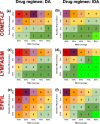COMET-LF: a compartmental model of dynamics of infection, disease, and elimination strategies for lymphatic filariasis
- PMID: 41199190
- PMCID: PMC12590670
- DOI: 10.1186/s12879-025-11691-y
COMET-LF: a compartmental model of dynamics of infection, disease, and elimination strategies for lymphatic filariasis
Abstract
Background: Lymphatic filariasis (LF) is a mosquito-borne disease caused by filarial worms. The WHO has targeted LF elimination by 2030. Mathematical models can help evaluate and guide elimination strategies.
Methods: We developed a new compartmental model—COmpartmental Modelling of Elimination strategies and Transmission of Lymphatic Filariasis (COMET-LF)—to assess the impact of mass drug administration (MDA) on LF elimination. Our model incorporates efficacy data from clinical trials and generates estimates of disease (lymphoedema and hydrocele) prevalence. The model is calibrated to publicly available microfilaria (Mf) and disease prevalence data (2008-2013), and validated using programmatic data (2018-2019) from ten endemic districts of Bihar, India.
Results: COMET-LF simulation projected that at 85% coverage with a two- or three-drug regimen, six rounds of MDA should be sufficient to achieve elimination for baseline Mf prevalence up to 10%, consistent with the existing models - EPIFIL and LYMFASIM. The impact of MDA on disease burden, generated using COMET-LF, suggest that the disease prevalence reduces over much longer timescales - 20 years for a reduction of 8%-11.5% following 5 rounds of MDA. To investigate the role of migration, we implemented COMET-LF within a meta-population model. We found that high Mf prevalence in the spatial neighbourhood can require up to 3 additional rounds for the two-drug regimen. Migration between non-endemic and adjacent endemic regions (>5% Mf) may lead to a significant risk of resurgence.
Conclusion: Our COMET-LF model can capture LF transmission dynamics and estimate the number of MDA rounds required to reach elimination. MDA coverage, baseline Mf prevalences and human migration are the determinants of the required rounds of MDA. Our model can be easily tailored to specific blocks and districts to guide programmatic intervention for LF elimination and disease management.
Supplementary Information: The online version contains supplementary material available at 10.1186/s12879-025-11691-y.
Keywords: Disease prevalence estimation; Lymphatic filariasis; Mass drug administration; Mathematical modelling; Migration.
Conflict of interest statement
Declarations. Ethics approval and consent to participate: Not applicable. Consent for publication: Not applicable. Competing interests: The authors declare no competing interests.
Figures






References
-
- Global programme to eliminate lymphatic filariasis: progress report. 2022. https://www.who.int/publications/i/item/who-wer9841-489-502. Accessed 02 Jan 2024.
-
- Lymphatic filariasis factsheet (World Health Organization). https://www.who.int/news-room/fact-sheets/detail/lymphatic-filariasis. Accessed 02 Jan 2024.
-
- Organisation mondiale de la Santé, World Health Organization, et al. Global programme to eliminate lymphatic filariasis: progress report, 2021–Programme mondial pour l’élimination de la filariose lymphatique: rapport de situation, 2021. Wkly Epidemiol Rec = Relevé Épidémiologique Hebdomadaire. 2022;97(41):513–24.
-
- National Vector Borne Disease Control Programme, National Health Mission. VL/LF update. Newsletter for visceral leishmaniasis (VL) and lymphatic filariasis (LF). Issue No. 4. NVBDCP; 2023. https://ncvbdc.mohfw.gov.in/Doc/VL-LF-Newsletter-December-2023.pdf. Accessed 25 Jun 2024.
Grants and funding
LinkOut - more resources
Full Text Sources

